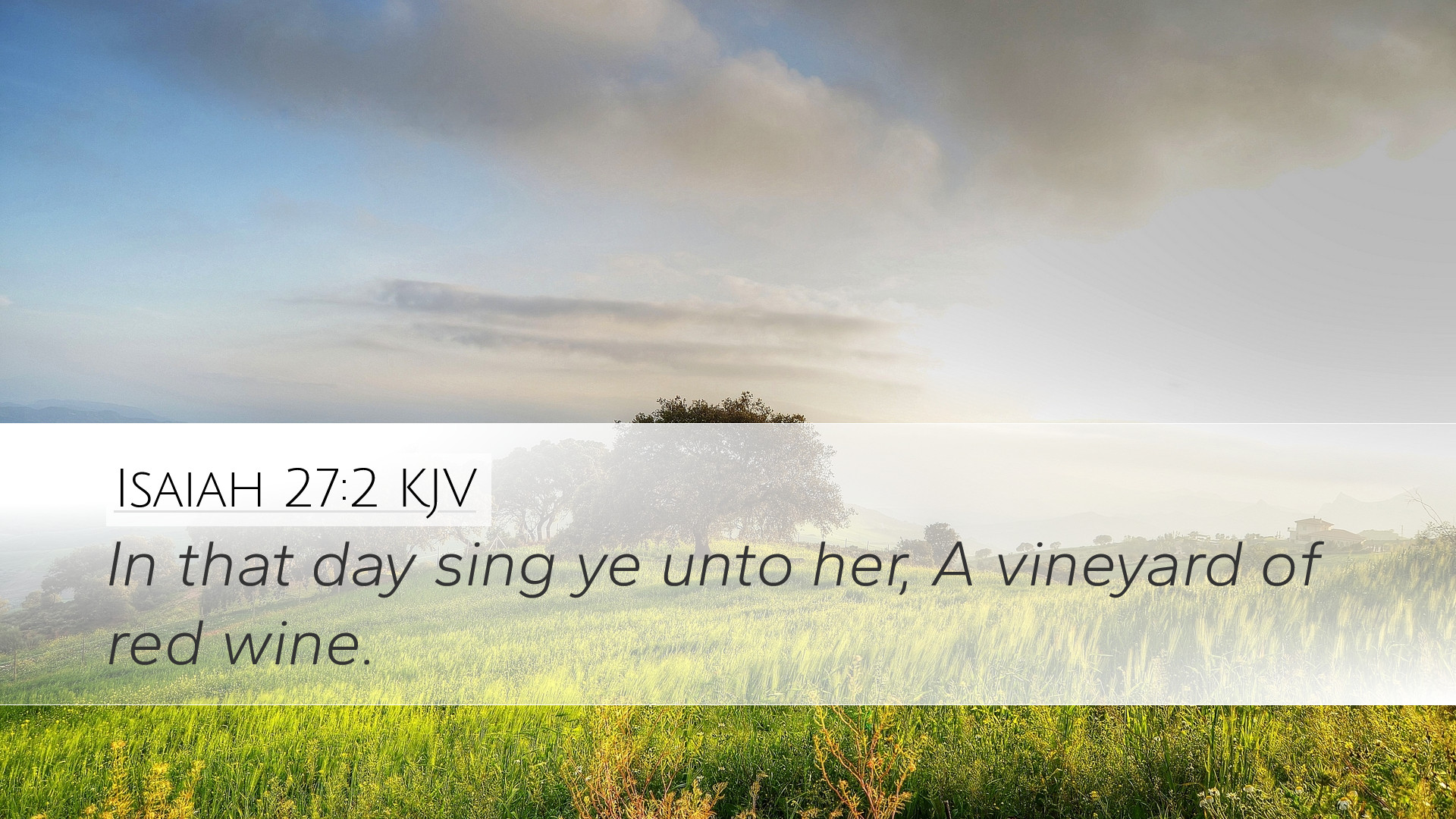Commentary on Isaiah 27:2
Introduction
Isaiah 27:2 contains the profound symbolism and imagery that characterize the writings of the prophet Isaiah. This verse not only speaks to the context of God's judgment and deliverance but also expresses a promise of restoration. In this commentary, we will glean insights from public domain sources such as Matthew Henry, Albert Barnes, and Adam Clarke, enriching our understanding of this verse for pastors, students, theologians, and Bible scholars.
Text of Isaiah 27:2
"In that day, sing ye unto her, A vineyard of red wine." (Isaiah 27:2, KJV)
Contextual Analysis
This verse is placed within a larger narrative concerning the restoration of Israel, signifying a shift from desolation to joy. Isaiah, often a voice of warning, now turns to a message of hope that speaks of the future restoration of God’s people. The phrase "In that day" signifies a determined time of God’s intervention and celebration.
Commentary Insights
Matthew Henry's Insights
Matthew Henry emphasizes the joyous nature of God's restoration. He interprets the "vineyard" as a symbol of God's people, cherished and cared for by Him. He states that this vineyard not only represents Israel but also embodies the abundance of blessings that will pour forth when God's favor is returned. Moreover, Henry draws attention to the need for singing—a communal response to divine benevolence indicative of a vibrant faith life.
Albert Barnes' Perspective
Albert Barnes provides a deeper exploration into the metaphor of the "vineyard of red wine." He signifies that vineyards are often symbols of peace and prosperity in biblical literature. The "red wine" here may symbolize joy and the blessings of God's providence. Barnes notes that the singing called for here is an expression of gratitude and celebration for the blessings received and is meant to inspire others in recognizing God’s grace.
Adam Clarke's Commentary
Adam Clarke offers a theological reflection on the nature of the vineyard in Isaiah 27:2. He discusses the care taken by the vinedresser, likening it to God's meticulous attention to the people of Israel. Clarke states that this verse carries a dual aspect: it both celebrates God’s past faithfulness and anticipates future restoration. His insight captures the essence of God as both a judge and a redeemer.
Theological Implications
The implications of Isaiah 27:2 are profound for theologians and scholars. The "vineyard" metaphor inscribes a theological narrative of care, judgment, and redemption. It highlights themes of divine sovereignty and the covenantal relationship between God and His people. This verse showcases the tension between judgment and mercy, urging believers to rejoice in God’s restoration while recognizing the seriousness of their covenantal obligations.
Applications for Ministry
For Pastors:
Pastors can draw upon Isaiah 27:2 to inspire congregations to celebrate God's faithfulness. The concept of singing about God's vineyard can encourage communal worship and highlight the importance of expressing gratitude in community settings.
For Students:
Biblical students are encouraged to study the contexts of restoration to appreciate the fullness of God’s promise. The theological depth within the symbolism can lead to richer biblical exegesis and understanding of God’s nature.
For Theologians:
Theologians should explore the eschatological implications of this verse, considering how the restoration sentiments of ancient texts apply to contemporary faith contexts. Analysis of God's ongoing covenant can form a vital part of systematic theology.
For Bible Scholars:
Scholars can consider how Isaiah 27:2 correlates with other vineyard parables in Scripture. This verse can be a focal point for discourses on God’s judgment and grace, calling for an intertextual study that weaves together various biblical themes.
Conclusion
Isaiah 27:2 serves as a watershed verse that articulates the shift from anticipation of judgment to the promise of restoration. Rich in imagery and profound in meaning, this passage provides fertile ground for scholarly inquiry, theological reflection, and practical ministry application. The insights of Matthew Henry, Albert Barnes, and Adam Clarke enrich our understanding and challenge us to recognize God's ongoing activity in our lives.


